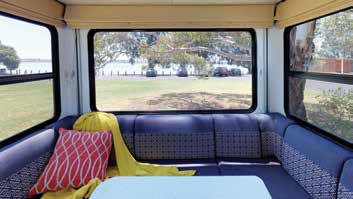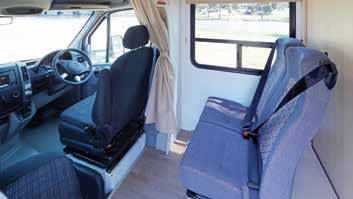
Going to shows is a great way to touch and feel a motorhome, and talk to the experts
For just about everyone, buying a new or second-hand motorhome is a major purchase and there are some important steps to take before you even consider buying, or upgrading, which could save you a lot of time, and more importantly, money.
CHECKING THE MARKET
Research is the most important first step and that can be done in any number of ways. Your local newsagent is a good start, but it’s slim pickings there for motorhome specific magazines, unless of course you’re already a CMCA member and have access to The Wanderer! On the internet, there is of course numerous websites from both manufacturers and dealers, not to mention several forum sites, which are often quite handy for advice from the user point of view. A little caveat here with forums and the ‘experts’ therein is to always try and check information from multiple sources, particularly where large expenses are considered.
TOUCH AND FEEL
In addition to letting your fingers do the walking, there are some practical steps to take by visiting the number of motorhome dealers like the RV Sales Centre in Braybrook, Melbourne. A slight problem in Australia is that motorhome dealers and manufacturers are often far apart and in different states, so be prepared to travel.
It’s well worth however, finding a dealer who can talk you through things like, an aspect often forgotten, which is the cab chassis, and particularly with second-hand vehicles, getting a bit of maintenance and mechanical history is recommended. Nothing like a bit of insider knowledge for potential maintenance costs.
COMFORT LEVELS
There are two comfort levels to consider. One being the interior space and features and the other being the size of the motorhome you and your partner are happy driving around and parking up. Those two are not necessarily compatible, that is the interior space desires might not match with the external size requirements. Getting a happy compromise is one way of ensuring happy motorhoming.
At the extreme budget end, a campervan may well keep the bank account looking good, but making the bed up every night might produce some unhappy campers. Time to move up to a larger motorhome! Similarly, a high level of comfortable interior space may make for great camping, but the road trip might be something different. Downsizing to a well appointed large van conversion or a C class unit with a slide-out may be the answer.
TRY BEFORE YOU BUY
It’s been mentioned before in this column but for motorhome newcomers, trying before you buy is recommended. Renting is the recommended course of action. In the case of KEA of course, it is possible to rent the same model motorhome you are planning on purchasing. If nothing else it will give a good idea of your ownpersonal requirements. One of the reasons is that people have different preferences – an obvious fact I know but sometimes in the excitement of a purchase, it gets a bit lost. Most couples like to get a double bed, but particularly in smaller layouts, single beds are more practical. Kitchen bench sizes can vary considerably, as do cooking requirements – always good to match both cook and kitchen. Similarly with bathrooms, they can take up a considerable amount of living space and whilst some will be happy with a small combo setup, others prefer the full monty. Dinettes are great places to sit and eat, but are they equally comfortable for lounging around? Often not, which is where either camp chairs under the awning come into play or if the weather is bad, swivelled cab seats.
TAKE A DRIVE
Something else that gets lost in the excitement is a test drive. Just like a car, motorhome cabs and driving positions can vary and getting that right is important. In second-hand vehicles, it’s a must for understanding the condition of the vehicle at least in the preliminary stages – a professional assessment is certainly recommended.

Consider the interior fit-out you need carefully before you buy
BASE VEHICLES
For the most part in the current Australian market, there are four choices of new cab chassis. Mercedes Benz Sprinter, Iveco Daily, Fiat Ducato, and Isuzu NPR. There are a few new motorhomes around with Renault cab chassis and both VW (Crafter) and Ford (Transit) have had a past history in Australia and are expected to have new models in the future. All are European except for the Japanese built Isuzu. The Isuzu tends to be more truck-like to drive than the Euro-built vehicles, which are certainly more comfortable and just about all can be fitted with swivelling cab seats, a major space saver. All are rear wheel drive, except for the Fiat Ducato. Some get a little put off by that, but Fiat do have the lion’s share of the market in Europe which tells you something. Chinese built cab chassis has a presence in the Australian light commercial vehicle market, but so far with minimal penetration in the motorhome market.
SECOND-HAND VEHICLES
Not everybody can afford to buy a new motorhome, which is why the secondhand market is where many spend their time looking. There are some risks with overall vehicle condition of course, but a thorough inspection is the order of the day. An initial one does not even have to be professionally done. A good poke around in dark cupboards with a torch and your nose may well tell you all you need to know. As do odd looking stains around the roof area. Don’t forget to look under the motorhome – road damage can be very telling. Getting the dealer or seller (if private) to demonstrate that all appliances function prior to purchase is not unreasonable. Ex-rental motorhomes, such like you might find at the RV Super Centre, are often cheaper than those from the retail market, but that is because they most likely have been well used. Generally speaking, rental vehicles are built for the hard knocks school, but at the same time will have been reasonably maintained for presentation to rental customers. Taking a good look for external damage is a wise move, given many drivers are often inexperienced.

TIMING
Plan to spend a considerable amount of time looking around on your motorhome purchase. Two years is not unreasonable. Sure prices will almost certainly rise during that time with new vehicles, but the second-hand market won’t change as much and especially in the latter case, your dream motorhome may well appear if you are a bit patient. At least one dealer I know tells me they have regular ‘lookers’. Over several months, they turn up several times just to have a look around and sit in a possible purchase for a while. Car sales techniques really don’t work in the RV industry, which is why a dealer has to be patient.

Motorhomes, much like cars, should be test driven before you buy
Category: Features
Written: Thu 01 Mar 2018
Printed: March, 2018
Published By: